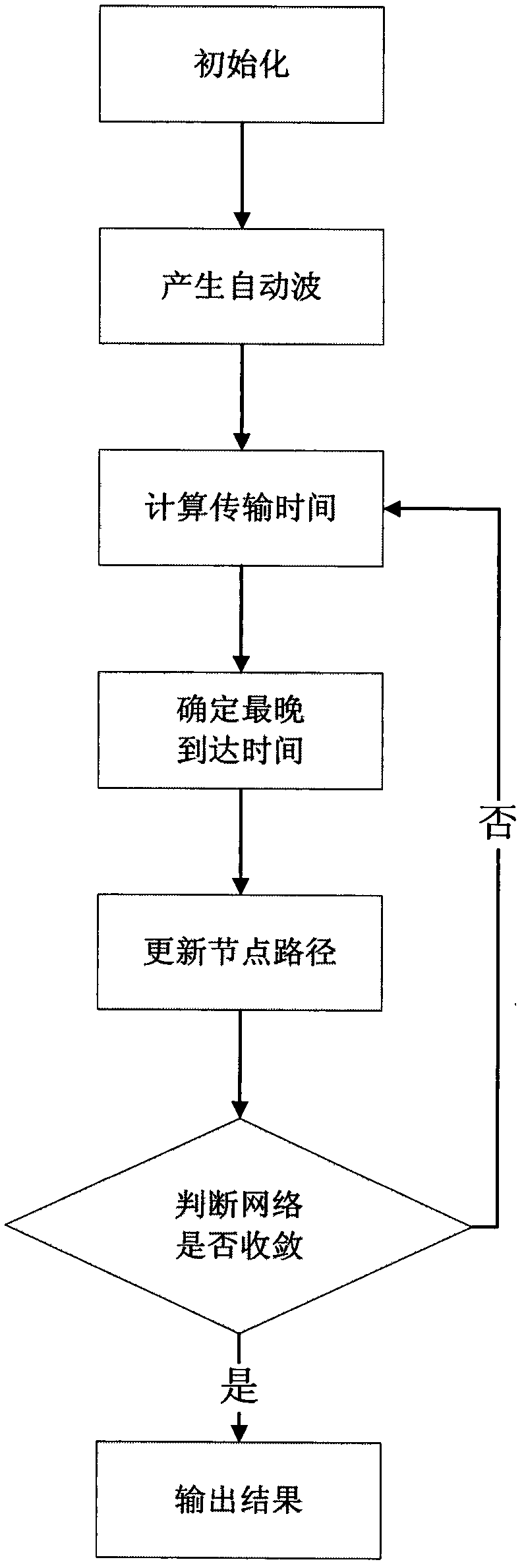Method for figuring out shortest path of large scale graphs based on fewest resource neural networks
A shortest path and neural network technology, applied in the direction of biological neural network models, can solve the problems that the quality and computational complexity are easily affected by other parameters, affect the total number of iterations of network convergence, and cannot be applied to large-scale problems. Effects of quality and computational complexity, minimal resources, fast convergence
- Summary
- Abstract
- Description
- Claims
- Application Information
AI Technical Summary
Problems solved by technology
Method used
Image
Examples
Embodiment 1
[0039] Example 1: Comparison between the present invention and the Dijkstra method Dijkstra, the A-star method A* and the pulse-coupled neural network method PCNN in the prior art under simulated data.
[0040] Embodiment 1 has selected Dijkstra method Dijkstra of prior art, A star method A* and these three methods of pulse-coupled neural network PCNN and the present invention in the quality Quality of solution, CPU running time CPU time and number of iterations Iters are compared in three aspects. The four methods in Embodiment 1 are all coded and implemented in the vc++6.0 environment, and run on a computer with a 2.5GHz processor and 2G memory.
[0041] In the traditional Dijkstra method Dijkstra, the A star method A* and the pulse-coupled neural network method PCNN in the prior art, the Dijkstra method Dijkstra finds the single-source shortest path that does not contain negative edges in the graph, and generates a shortest path tree. The A star method A* solves the short...
Embodiment 2
[0050] Embodiment 2 is the comparison result of the present invention and the prior art Dijkstra method Dijkstra large-scale real data.
[0051]
[0052] Embodiment 2 compares the present invention with large-scale real data. Embodiment 2 selects six large-scale urban maps on the website http: / / www.dis.uniroma1.it / ~challenge9 / index.shtml, respectively New York, San Francisco Bay area, Colorado, Florida, Northwest USA and Northeast USA. The first five nodes are set as source nodes respectively, and the average performance of Dijkstra's method Dijkstra and the present invention in terms of solution quality, iterations and CPU time are compared. Embodiment 2 runs on a computer with a 3.6GHz processor and 3G internal memory.
[0053] The above table is obtained after comparing the Dijkstra method Dijkstra of the present invention and the prior art in terms of iterations, CPU running time CPU time and solution quality. It can be seen from the above table that for large-scale ...
PUM
 Login to View More
Login to View More Abstract
Description
Claims
Application Information
 Login to View More
Login to View More - R&D
- Intellectual Property
- Life Sciences
- Materials
- Tech Scout
- Unparalleled Data Quality
- Higher Quality Content
- 60% Fewer Hallucinations
Browse by: Latest US Patents, China's latest patents, Technical Efficacy Thesaurus, Application Domain, Technology Topic, Popular Technical Reports.
© 2025 PatSnap. All rights reserved.Legal|Privacy policy|Modern Slavery Act Transparency Statement|Sitemap|About US| Contact US: help@patsnap.com



